Elementary functions 1
Contents
Elementary functions 1#
In this notebook we define some of the most common functions in general mathematics. Readers might be familiar with most of this content from school, but it will serve as a nice transition point towards more rigorous sections. This notebook should also serve as a small collection of examples for previous notebooks in this section.
Polynomial function#
A polynomial of degree \(n \in \mathbb{N}\) is a real function of a real variable given by the formula:
where \(a_0, a_1, \dots, a_n \in \mathbb{R}\) are the polynomial coefficients such that \(a_n \neq 0\). The natural domain of polynomial functions is the entire \(\mathbb{R}\).
import numpy as np
import matplotlib.pyplot as plt
x = np.linspace(-5, 5, 100)
titles = [['$p(x)=1$', '$x + 3$' ,'$x^2 - 2$'],
['$x^3 + x^2 - 10x + 8$', '$x^4 - 13x^2 + 12x$' ,'$x^5 + 3.5x^4 - 2.5x^3$ \n $- 12.5x^2 + 1.5x + 9$']]
fig, ax = plt.subplots(2, 3, figsize=(8, 6))
fig.tight_layout(pad=3.)
ax[0, 0].plot(x, [1] * len(x))
ax[0, 1].plot(x, x + 3)
ax[0, 2].plot(x, x**2 - 2)
ax[1, 0].plot(x, x**3 + x**2 - 10*x + 8)
ax[1, 1].plot(x, x**4 - 13*x**2 + 12*x)
ax[1, 2].plot(x, x**5 + 3.5*x**4 - 2.5*x**3 - 12.5*x**2 + 1.5*x + 9)
ax[0, 0].set_ylim(-2, 2)
ax[1, 0].set_ylim(-5, 30)
ax[1, 1].set_ylim(-80, 30)
ax[1, 2].set_ylim(-5, 12)
for i in range(2):
for j in range(3):
ax[i, j].spines['left'].set_position('zero')
ax[i, j].spines['bottom'].set_position('zero')
ax[i, j].spines['right'].set_visible(False)
ax[i, j].spines['top'].set_visible(False)
ax[i, j].set_title(titles[i][j])
ax[i, j].set_yticks([])
plt.show()
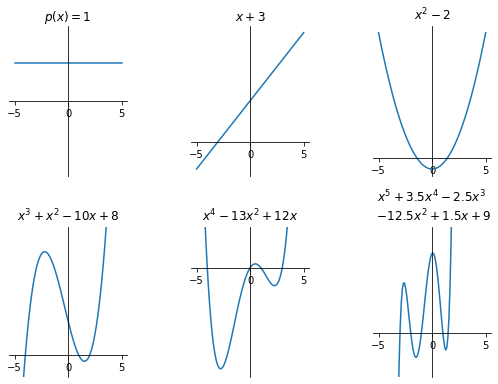
Linear functions#
Quadratic functions#
A function given by the formula \( f(x) = ax^2 + bx + c, a \neq 0 \) is called the quadratic function. We call its graph a parabola. The roots of a quadratic function are given by:
The quadratic function can be written in vertex form as \(f(x) = a \left ( x + \frac{b}{2a} \right ) + c - \frac{b^2}{4a}\) from which we see that its vertex position is
where the number
is called the discriminant of a quadratic function. The discriminant is important because it tells us about the null-points (roots) of the function, which are given by
Therefore, if:
\(D < 0\), no real roots, i.e. \(x_1, x_2 \notin \mathbb{R}\)
\(D = 0\), one real root i.e. \(x_1, x_2 \in \mathbb{R} : x_1 = x_2\)
\(D > 0\), two real roots, i.e. \(x_1, x_2 \in \mathbb{R} : x_1 \neq x_2\)
Rational functions#
A rational function is a real function of a real variable given by the formula:
where \(p\) and \(q\) are real polynomials. The natural domain of \(r(x)\) is the entire \(\mathbb{R}\) without the null-points of \(q(x)\) (we cannot divide by zero). That is, \(r(x)\) is defined on \(\mathbb{R} \backslash \{ x \in \mathbb{R} : q(x) = 0 \}\).
# for demonstration purposes will suppress warnings when div by 0
import warnings; warnings.simplefilter('ignore')
x = np.linspace(-5, 5, 101)
fig, ax = plt.subplots(1, 2, figsize=(8, 4))
ax[0].plot(x, 1/x)
ax[0].set_title(r'$r(x) = \frac{1}{x}$', fontsize=16)
ax[1].plot(x, (x**3 + 3)/(-x + 2))
ax[1].set_title(r'$r(x) = \frac{x^3 + 3}{-x + 2}$', fontsize=16)
for i in range(2):
ax[i].spines['left'].set_position('zero')
ax[i].spines['bottom'].set_position('zero')
ax[i].spines['right'].set_visible(False)
ax[i].spines['top'].set_visible(False)
ax[i].set_yticks([])
plt.show()
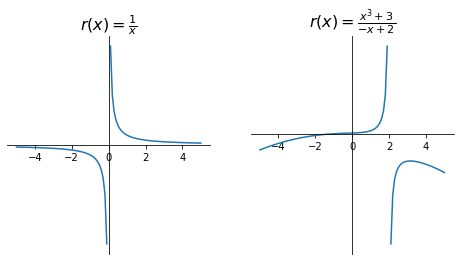
Exponential function#
An exponential function is a function of the form
where \(a\) is called the base and is a positive real number different from \(1\). A special case of an exponential function is the natural exponential function \(f(x) = e^x\) where the base is \(e \approx 2.718282...\) (Euler’s number).
The natural domain of an exponential function is the entire set \(\mathbb{R}\) and its image is \((0, + \infty)\), i.e. \(a^x > 0, \forall x \in \mathbb{R}\). Exponential function \(x \mapsto a^x\) always crosses the y-axis at point \((0, 1)\) since \(a^0 = 1\).
Exponential function \(f(x) = a^x\) is:
strictly increasing if \(a > 1\)
strictly decreasing if \(0 < a < 1\)
x = np.linspace(-3, 3, 100)
fig, ax = plt.subplots(1, 2, figsize=(8, 3))
fig.suptitle(r'$f(x) = a^x$', fontsize=16)
ax[0].plot(x, 2**x)
ax[0].set_title(r'$a > 1$')
ax[1].plot(x, 0.4**x)
ax[1].set_title(r'$0 < a < 1$')
for i in range(2):
ax[i].plot(0, 1, 'bo')
ax[i].spines['left'].set_position('zero')
ax[i].spines['bottom'].set_position('zero')
ax[i].spines['right'].set_visible(False)
ax[i].spines['top'].set_visible(False)
ax[i].set_yticks([1])
plt.show()
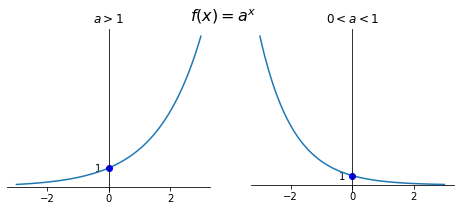
Hyperbolic functions#
Using the exponential function we define hyperbolic functions as follows:
x = np.linspace(-2.5, 2.5, 100)
fig, ax = plt.subplots(1, 2, figsize=(10, 5))
ax[0].plot(x, np.sinh(x), label=r'$sinh(x)$')
ax[0].plot(x, np.cosh(x), label=r'$cosh(x)$')
ax[0].plot(x, np.exp(-x) / 2, '--k', alpha=0.3)
ax[0].plot(x, np.exp(x)/2, '--k', alpha=0.3)
ax[0].text(-2, 0.4, r'$\frac{1}{2}e^x$')
ax[0].text(2, 0.4, r'$\frac{1}{2}e^{-x}$')
ax[1].plot(x, np.tanh(x), label=r'$tanh(x)$')
ax[1].plot(x, 1 / np.tanh(x), label=r'$coth(x)$')
ax[1].set_ylim(-2, 2)
ax[1].hlines(1, -2.5, 2.5, linestyles='--', alpha=0.3)
ax[1].hlines(-1, -2.5, 2.5, linestyles='--', alpha=0.3)
ax[1].set_yticks([-2, -1, 1, 2])
for i in range(2):
ax[i].spines['left'].set_position('zero')
ax[i].spines['bottom'].set_position('zero')
ax[i].spines['right'].set_visible(False)
ax[i].spines['top'].set_visible(False)
ax[i].legend(loc='best')
plt.show()
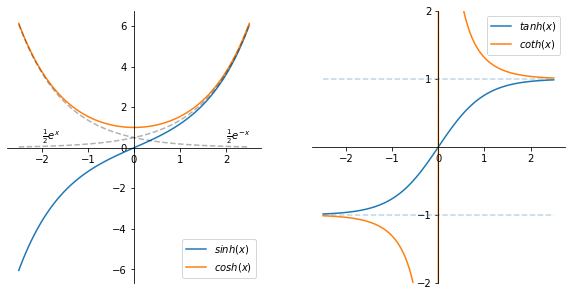
Properties
\(\sinh x\) |
\(\cosh x\) |
\(\tanh x\) |
\(\coth x\) |
|
|---|---|---|---|---|
Domain |
\(\mathbb{R}\) |
\(\mathbb{R}\) |
\(\mathbb{R}\) |
\(\mathbb{R} \backslash \{ 0 \}\) |
Image |
\(\mathbb{R}\) |
\((1, + \infty)\) |
\((-1, 1)\) |
\((- \infty, -1) \cup (1, + \infty)\) |
Monotonic? |
strictly increasing |
strictly decreasing on \((- \infty, 0]\), strictly increasing on \([0, + \infty)\) |
strictly increasing |
strictly decreasing on \((- \infty, 0)\) and \((0, + \infty)\) |
Even/odd? |
Odd |
Even |
Odd |
Odd |
Similar to the Pythagorean trigonometric identity, the principal formula for hyperbolic functions is:
Also similar are the argument addition and subtraction formulae:
Trigonometric functions#
The radian is a measurement of the angle formed by two radii of a unit circle connecting the circle arc of unit length. \(2 \pi rad = 360^\circ\)
A function \(f: \mathcal{D} \to \mathbb{R}\) is periodic with a period \(\tau > 0\) if for all \(x \in \mathcal{D}\):
\( x + \tau \in \mathcal{D} \)
\(f(x + \tau) = f(x)\).
Note that if \(\tau\) is a period of a function, any multiple of it is also a period of the same function. We therefore define the fundamental period (also primitive, basic and prime period) as the smallest positive period.
 | 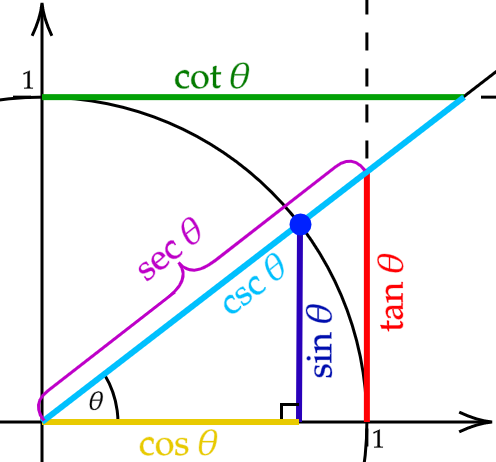 |
The six trigonometric functions are sine, cosine, tangent and their inverses cosecant, secant, cotangent, respectively. We can define them for acute angle \(\theta\) in right-angled triangles as follows:
And their inverses:
To extend the definitions of trigonometric functions to the entire set \(\mathbb{R}\) we could consider a unit circle centered at the origin. The \(x\) and \(y\) coordinates of a point on a circle is then \(\cos \theta\) and \(\sin \theta\), respectively, where \(\theta\) is the angle between the x-axis and the line joining the point and the origin. Using sine and cosine we can then define the other four functions.
x = np.linspace(-8, 8, 200)
fig, ax = plt.subplots(3, 1, figsize=(8, 14), gridspec_kw={'height_ratios': [2, 2, 3]})
_y = 1. / np.sin(x)
_y[:-1][np.abs(np.diff(_y)) > 10] = np.nan # avoid joining lines
ax[0].plot(x, np.sin(x), label=r'$\sin x$')
ax[0].plot(x, _y, label=r'$\csc x$')
_y = 1. / np.cos(x)
_y[:-1][np.abs(np.diff(_y)) > 10] = np.nan
ax[1].plot(x, np.cos(x), label=r'$\cos x$')
ax[1].plot(x, _y, label=r'$\sec x$')
_y = np.tan(x)
_y[:-1][np.diff(_y) < 0] = np.nan
ax[2].plot(x, _y, label=r'$\tan x$')
_y = 1. / np.tan(x)
_y[:-1][np.diff(_y) > 0] = np.nan
ax[2].plot(x, _y, label=r'$\cot x$')
for i in range(3):
ax[i].spines['left'].set_position('zero')
ax[i].spines['bottom'].set_position('zero')
ax[i].spines['right'].set_visible(False)
ax[i].spines['top'].set_visible(False)
ax[i].legend(loc='lower right')
ax[i].set_xticks(np.pi * np.array([-2, -1.5, -1, -0.5, 0, 0.5, 1, 1.5, 2]))
ax[i].set_xticklabels(['$-2\pi $', r'$-\frac{3}{2} \pi $', r'$-\pi$',
r'$-\frac{1}{2}\pi$', '0', r'$\frac{1}{2}\pi$',
r'$\pi$', r'$\frac{3}{2}\pi$', r'$2\pi$'])
ax[i].set_ylim(-4, 4)
plt.show()
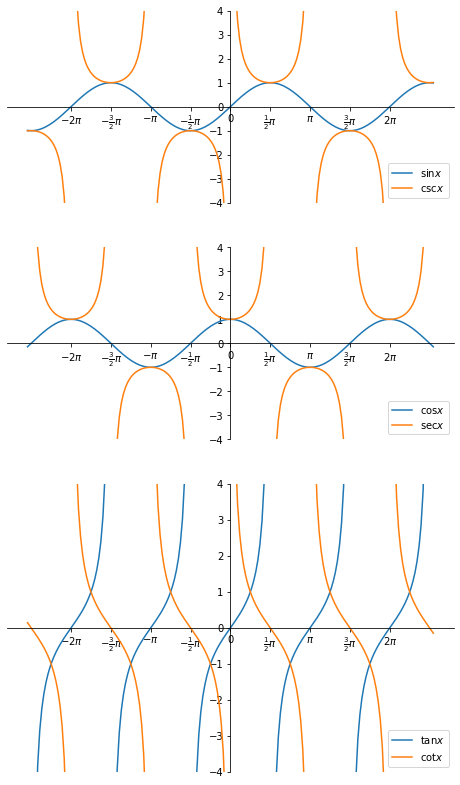
Properties
\(\sin x\) |
\(\cos x\) |
\(\tan x\) |
\(\csc x\) |
\(\sec x\) |
\(\cot x\) |
|
|---|---|---|---|---|---|---|
Roots |
\(k \pi\) |
\(\frac{2k + 1}{2} \pi\) |
\(k \pi\) |
None |
None |
\(\frac{2k + 1}{2} \pi\) |
Period |
\(2 \pi\) |
\(2 \pi\) |
\(\pi\) |
\(2 \pi\) |
\(2 \pi\) |
\(\pi\) |
Domain |
\(\mathbb{R}\) |
\(\mathbb{R}\) |
\(\mathbb{R} \backslash \{ \frac{2k + 1}{2} \pi \}\) |
\(\mathbb{R} \backslash \{ \frac{2k + 1}{2} \pi \}\) |
\(\mathbb{R} \backslash \{ k \pi \}\) |
\(\mathbb{R} \backslash \{ k \pi \}\) |
Image |
\([-1, 1]\) |
\([-1, 1]\) |
\(\mathbb{R}\) |
\((- \infty, -1] \\ \cup [1, + \infty)\) |
\((- \infty, -1] \\ \cup [1, + \infty)\) |
\(\mathbb{R}\) |
Even/odd? |
Odd |
Even |
Odd |
Even |
Odd |
Odd |
where \(k \in \mathbb{Z}\).
Pythagorean trigonometric identity:
Angle addition and subtraction formulae:

